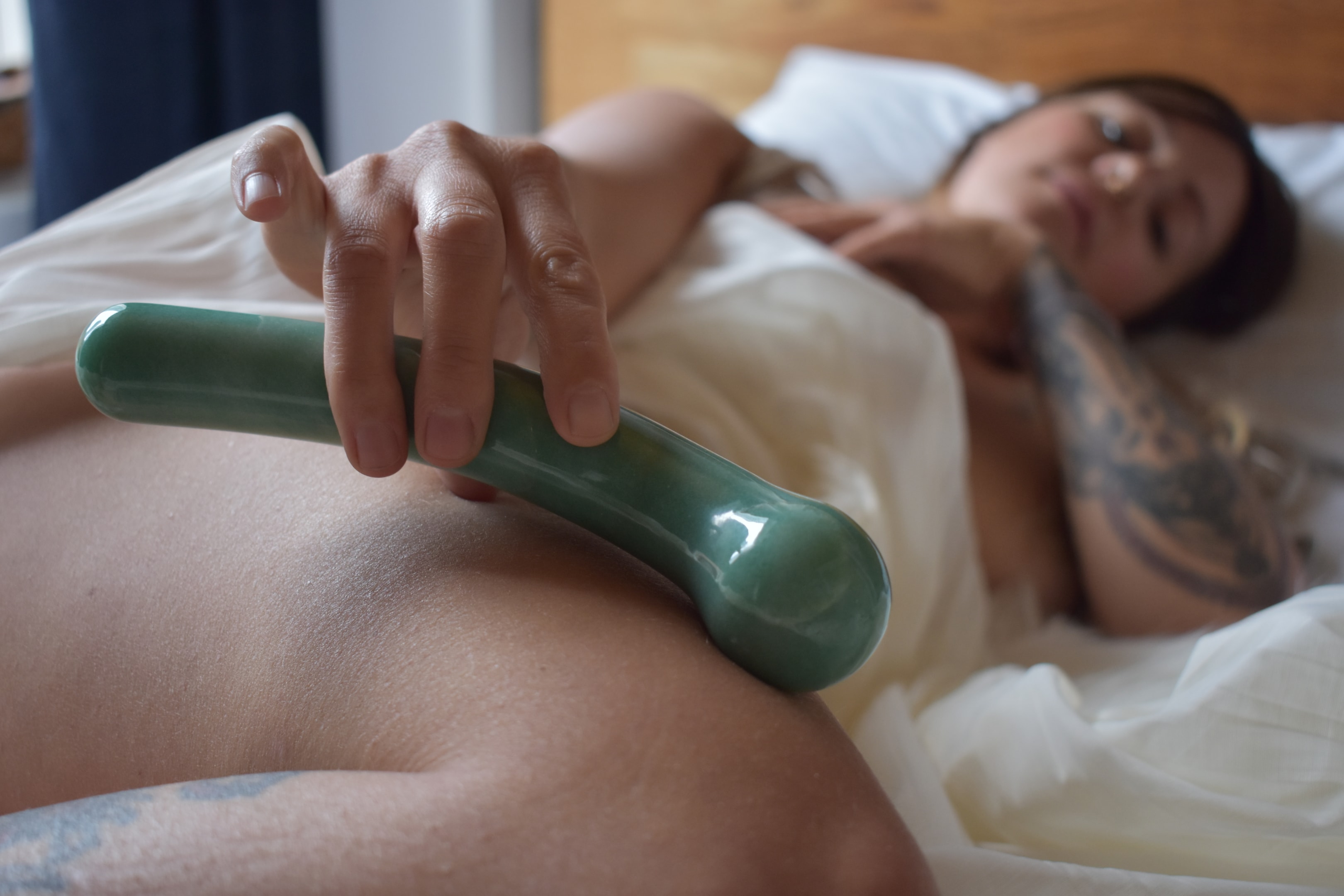
Table of Contents ▾
The pelvic bowl is a dynamic part of your body that affects how you feel during sex, how you go to the bathroom, and how stable you feel in everyday movement.
When it’s not working as it should, the signs can be subtle at first. Maybe you feel more tension during penetration, your lower belly holds a quiet pressure, or you’ve started leaking a little when you laugh.
Tightness and weakness can show up differently, but both can affect your sexual function, sensation, and confidence in your body.
This article walks you through the real signs of a tight vs. weak pelvic floor, what each means, and how to start supporting your pelvic health in a way that feels nourishing.
Understanding Pelvic Floor Dysfunction
Pelvic Floor Dysfunction happens when the muscles at the base of your pelvis stop working the way they’re supposed to. Sometimes they’re too tight. Sometimes they’re too weak, and sometimes they just don’t respond when you need them to. That’s when everyday things, like going to the bathroom, having sex, or simply moving, start to feel off.
The pelvic floor muscles span the base of the pelvis, performing three essential jobs, and each one matters more than most women realize:
Supports your bladder, bowel, and uterus
Your pelvic floor is made up of layers of muscle that act like a sling, holding your pelvic organs in place. When these muscles are functioning well, they prevent organs from shifting downward, a condition known as pelvic organ prolapse. Proper support means you don’t feel that heavy, dragging sensation in your lower belly, especially by the end of the day.
Controls how and when you go to the bathroom
The pelvic floor works like a valve system. When it contracts, it helps you “hold it in.” When it relaxes, it allows you to fully empty your bladder or bowels without straining. Healthy muscle tone and timing are what prevent leaks when you cough or jump, and what make it possible to go without pushing or discomfort.
Enhances sexual sensation, arousal, and orgasm
During arousal, the pelvic floor increases blood flow to the vaginal and clitoral tissues. This boosts natural lubrication, heightens sensation, and supports tissue swelling that makes intimacy feel pleasurable. During orgasm, these muscles contract rhythmically, so when they’re strong and coordinated, your orgasms are more intense and more satisfying. A responsive pelvic floor also helps you feel more connected to your body during sex, instead of numb, tense, or disconnected.
The Link Between Pelvic Floor Dysfunction and Emotional Disconnection

The pelvic floor is a group of muscles at the base of your body, but it’s also a place your nervous system responds through. When you feel stressed, unsupported, or on edge, those muscles often tighten without you realizing it.
For many women, that tension becomes baseline. It can build slowly, after years of rushing, shallow breathing, bracing during penetration, or pushing through physical pain without pause. Over time, the muscles either stay clenched or lose their ability to respond properly. That’s when issues start like pain during sex, leaking, vaginal heaviness, or a constant feeling of internal tightness.
When your pelvic floor stays in a holding pattern, it becomes harder to access sensation and desire. You might feel less connected to your sexuality and it may be more difficult to stay present during sex or even know what kind of touch feels good.
Rebuilding Connection
Reconnection starts with noticing. You might begin by feeling how your pelvis holds itself when you’re doing nothing at all, sitting, standing, lying down.
From there, gentle pelvic floor release work can support your system in learning something new. Slow, supported stretches, like child’s pose, deep squat holds, or lying butterfly with breath, help your body downshift out of its default state of bracing.
Tools like crystal wands, yoni eggs, and even crystal butt plugs. when used intentionally, help you locate where sensation exists and where it fades. You might discover areas inside that feel unreachable. You might find emotions come up when you touch a certain side of the vaginal wall or press gently into the cervix. All this tells you where your body is asking to be met.
Signs Your Pelvic Floor Is Too Tight
Pelvic Pain: You might notice a deep, constant ache low in your abdomen, like a heavy knot that never softens. Sitting too long can trigger sharp stabs around your tailbone or a bruised feeling at your sit bones. They’re the result of muscles that are locked in contraction, pulling on connective tissues, nerves, and joints with no release in sight. This condition is often referred to as a hypertonic pelvic floor, where the pelvic floor muscles are excessively tight and unable to relax.
Painful Intercourse: Many women describe a burning sensation, or the feeling that their partner is “hitting resistance” too soon. This is muscle tension at the entrance and along the vaginal canal, creating a literal barrier to pleasure.
Urinary Symptoms: You might feel the urge to pee all the time, even when your bladder is nearly empty. That’s because the tension makes your nervous system misfire, sending false signals that trick you into thinking you need to go. Starting a stream can also feel awkward or delayed. You pee, but it still feels like something’s left behind. In severe cases, this can even lead to urinary retention (not fully emptying) or increased risk of UTIs, because bacteria isn’t being flushed out properly.
Bowel Issues: Bowel movements require muscles to drop and widen, like a drawbridge opening. But with chronic tightness, the exact opposite happens. The muscles stay clenched, even when you’re trying to bear down. You push harder, you shift positions and you feel pressure without progress. When the body doesn’t feel safe, it holds. And when the muscles responsible for letting go are locked in tension, you get incomplete elimination, constipation, or the feeling of always needing to go, but not being able to.
Muscle Spasms and Tension: You might feel a low-grade buzz of tightness in your lower belly that never quite goes away. It could be flickering twitch in your glutes when you’re lying in bed, or a grip in your inner thighs or perineum, like they’re holding tension for reasons you can’t explain.
Signs Your Pelvic Floor Is Too Weak
Bladder Control Issues: When the pelvic floor is too weak to counteract pressure from above, your abdominal pressure increases every time you cough, bend, lift, or jump. Without a firm muscular response from below, that pressure pushes straight down onto the bladder. And if the muscles can’t resist it, urine slips out, whether you're ready or not.
Pelvic Pressure and Prolapse: When the pelvic floor weakens, it loses its ability to lift and hold the organs above it: bladder, uterus, rectum. Gravity pulls down. You feel it, like something is dropping internally. Some women describe a bulge near the vaginal opening, others feel an internal heaviness, like their insides are sliding out of place.
Bowel Problems: Maybe gas slips out before you can stop it or wiping feels incomplete, like your body didn’t fully finish. Or you find yourself racing to the bathroom with little warning, and not always making it in time. When the back portion of the pelvic floor weakens, it can’t properly seal or support the rectum. You lose that crucial second of warning, where your body signals, holds, and lets you decide when to release. Without that control, accidents become unpredictable.
Sexual Dysfunction: When the pelvic floor lacks tone, it can’t respond to arousal with the same dynamic contraction. You lose that rhythmic pulsing that builds toward orgasm. You might feel less sensation during penetration, or orgasms that feel weak, short, or hard to access.
Postpartum Weakness: You can’t feel your pelvic floor the way you used to. Lifting your baby makes your lower belly ache, or standing for too long feels like your organs are sinking. There’s an unsettling emptiness in your core, like your inner scaffolding is missing. During labor, the pelvic floor muscles stretch dramatically, sometimes tearing or losing connection to the brain entirely. Without intentional recovery, that disconnection becomes the new normal. You can’t strengthen what you can’t feel. And without pelvic support, your entire core system, abdominals, spine, even breath, struggles to coordinate.
Yoni Eggs: A Natural Solution for Pelvic Floor Balance

For a tight pelvic floor
Tight muscles aren’t just tight, they’re guarded. Many women live in a state of low-grade bracing, clenching their pelvic floor without realizing it. Inserting a yoni egg gives those overactive muscles something to respond to. When you place the egg inside, you can feel right away if you're gripping around it. That feedback alone is enough to cue the body tto soften, breathe, let go. Over time, your muscles begin to relearn that they don’t need to be “on” all the time. They start to rest between contractions, which is what healthy function really looks like.
If you’ve been clenching for years, you might not even know what “relaxed” feels like anymore. A yoni egg makes that internal pattern visible. When you insert it and your body tries to grip, that sensation is immediate and clear and it gives your nervous system real-time feedback. You begin to notice when you're holding tension during sex, while walking, or even while lying down. That awareness is what allows you to interrupt the pattern and retrain your body to let go.
For a weak pelvic floor
A weak pelvic floor is under-stimulated. If the weak pelvic floor muscles don’t get regular, responsive engagement, they slowly stop firing. The weight and shape of the egg stimulate these sleepy muscles. You’re not just squeezing for the sake of it, you’re squeezing with purpose, learning to lift and hold something from the inside out. This kind of activation helps rebuild tone, control, and muscle reflex without over-clenching.
Using yoni eggs can significantly enhance pelvic floor strength. Many women with weak pelvic floors can’t tell if they’re activating anything at all. You try to “do a Kegel” and wonder if anything is actually happening. With the egg inside, you know. If your body lifts it, even slightly, you feel it. If not, you have something to work toward. This awareness helps build neuromuscular coordination, which is the foundation for a responsive, functional pelvic wellness floor.
Pleasure Wands: Releasing Tension and Reconnecting with Pleasure

For a tight pelvic floor
Tightness in the pelvic floor is stiffness that doesn’t budge. Intense pelvic floor pressure can exacerbate this condition. Crystal pleasure wands help by breaking that tension. By applying slow, gentle pressure with the wand, you create a physical cue for the muscle to release. This is different from stretching. It’s targeted, responsive touch that allows the nervous system to downregulate.
Stored tension doesn’t just block blood flow and movement, it holds stories. As you use the wand to gently soften through layers of gripping, your nervous system takes note. You might find yourself feeling emotions you didn’t expect as it’s a signal that your body finally feels safe enough to feel. And when your body feels safe, pleasure becomes accessible again.
For a weak pelvic floor
Weakness isn’t always about lack of strength, it’s often about lack of feedback. Pleasure wands create points of contact that your body can respond to. As you explore, you begin to notice what parts of your pelvic wall feel firm, what parts feel collapsed, and where sensation is missing entirely. This helps you retrain how your muscles activate. You can use the wand during gentle squeezes to improve precision and coordination, building control without bracing or overcompensating.
Where tightness guards, weakness often disconnects. And when the tissue is underused, it loses tone and responsiveness. With the wand, you can track how different regions respond as you move. You might feel one side engaging while the other stays flat. You might discover your front wall is awake, but your back wall feels missing.
Conclusion
If your pelvic floor feels tight, weak, or simply unfamiliar it means your body is communicating. And when you start listening closely, you’ll begin to notice how you brace without realizing it, how your pelvis responds during sex, how your breath gets shallow when you're stressed, or how a subtle heaviness shows up by the end of the day.
The goal isn’t to have a perfect pelvic floor, it’s to have a responsive one. One that knows how to activate when needed and soften when it’s safe. One that supports your bladder, bowels, and sexual response without running on autopilot.
This kind of body knowledge comes through noticing how your pelvis feels when you sit, how your breath moves when you lie down, and how sensation changes when you pause during intimacy and actually feel what’s happening.
FAQ
To tell if you have a tight or loose pelvic floor, start by paying attention to your pelvic floor symptoms. If you're experiencing pelvic pain, pain during sex, difficulty starting or finishing bowel movements, or a constant feeling of pressure in your pelvic area, you may be dealing with a tight pelvic floor. On the other hand, if you're leaking urine, feel heaviness in your vagina, or struggle with bladder or bowel leakage, you may have a weak pelvic floor.
Most women don't realize it's possible to have both tight pelvic floor muscles and pelvic floor muscle weakness at the same time. The muscles might be overworking just to hold things together, and still not functioning well.
One of the simplest ways to test for a tight pelvic floor at home is through internal self-assessment and breath awareness. Lie on a firm flat surface, place your hands on your belly and ribs, and take a slow diaphragmatic breath. If your belly rises but there's no drop or softening in the vaginal area, it's possible your pelvic floor is tight and not coordinating properly with your breath.
Other signs include tailbone pain, painful sex, difficulty inserting a tampon or wand, or needing to strain during urination or bowel movements. If you suspect pelvic floor tightness, a licensed pelvic floor physical therapist or pelvic health physiotherapist can perform a full assessment, checking for pelvic floor muscle tone, sensitivity, and the ability to both contract and release.
If your abdominal muscles are always on, if you hold your breath when stressed, or if you catch your pelvic muscles bracing during the day, especially while sitting, lifting, or even driving, you're likely experiencing pelvic floor tension.
Clenching often shows up with muscle tightness, pelvic discomfort, or a sense of always needing to go to the bathroom but not fully emptying. If your sit bones feel tense or your pelvic region never feels relaxed, these are clear signs of an overactive pelvic floor. You might also notice that relaxing feels harder than contracting, which points to a hypertonic pelvic floor pattern.
When you have both tight and weak pelvic floor muscles, the first step is releasing what's overactive. Stretching, relaxation techniques, and diaphragmatic breathing help reduce pelvic floor muscle tension and calm the nervous system.
Once your body learns to soften, you can introduce gentle, progressive pelvic floor exercises to build pelvic floor strength without adding more muscle tension. This includes mindful engagement (not aggressive Kegel exercises), posture support, and targeted activation of the pelvic floor muscles that span from pubic bone to tailbone.
